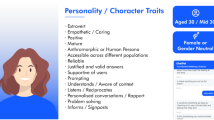Abstract
The aim of this paper is to assess the usability of a chatbot for mental health care within a social enterprise. Chatbots are becoming more prevalent in our daily lives, as we can now use them to book flights, manage savings, and check the weather. Chatbots are increasingly being used in mental health care, with the emergence of “virtual therapists”. In this study, the usability of a chatbot named iHelpr has been assessed. iHelpr has been developed to provide guided self-assessment, and tips for the following areas: stress, anxiety, depression, sleep, and self esteem. This study used a questionnaire developed by Chatbottest, and the System Usability Scale to assess the usability of iHelpr. The participants in this study enjoyed interacting with the chatbot, and found it easy to use. However, the study highlighted areas that need major improvements, such as Error Management and Intelligence. A list of recommendations has been developed to improve the usability of the iHelpr chatbot.
Access this chapter
Tax calculation will be finalised at checkout
Purchases are for personal use only
Similar content being viewed by others
References
Shevat, A.: Designing Bots: Creating Conversational Experiences. O’Reilly Media Inc., Newton (2017)
Kayak. https://www.kayak.com/messenger. Accessed 2 Aug 2018
Plum. https://withplum.com/. Accessed 2 Aug 2018
Følstad, A., Brandtzæg, P.B.: Chatbots and the new world of HCI. Interactions 24(4), 39–42 (2017)
Cameron, G., et al.: Towards a chatbot for digital counselling. In: Proceedings of the 31st British Computer Society Human Computer Interaction Conference, p. 24. BCS Learning & Development Ltd., Sunderland (2017). http://dx.doi.org/10.14236/ewic/HCI2017.24
Cameron, G., et al.: Best practices for designing chatbots in mental healthcare - a case study on iHelpr. In: Proceedings of the 32nd Human Computer Interaction Conference (2018). http://dx.doi.org/10.14236/ewic/HCI2018.129
Cameron, G., et al.: Back to the future: lessons from knowledge engineering methodologies for chatbot design and development. In: Proceedings of the 32nd Human Computer Interaction Conference (2018). http://dx.doi.org/10.14236/ewic/HCI2018.153
Stevenson, D., Farmer, P.: Thriving at work: the Stevenson/Farmer review of mental health and employers (2017)
Investors in People: Managing Mental Health in the Workplace 2018 (2018)
Miner, A., et al.: Conversational agents and mental health: theory-informed assessment of language and affect. In: Proceedings of the Fourth International Conference on Human Agent Interaction, pp. 123–130. ACM (2016). https://doi.org/10.1145/2974804.2974820
Bhakta, R., Savin-Baden, M., Tombs, G.: Sharing secrets with robots? In: EdMedia: World Conference on Educational Media and Technology, pp. 2295–2301. Association for the Advancement of Computing in Education (AACE) (2014)
Kavakli, M., Li, M., Rudra, T.: Towards the development of a virtual counselor to tackle students’ exam stress. J. Integr. Des. Process Sci. 16(1), 5–26 (2012). https://doi.org/10.3233/jid-2012-0004
Fitzpatrick, K.K., Darcy, A., Vierhile, M.: Delivering cognitive behavior therapy to young adults with symptoms of depression and anxiety using a fully automated conversational agent (Woebot): a randomized controlled trial. JMIR Mental Health 4(2) (2017). https://doi.org/10.2196/mental.7785
X2ai.com. http://x2ai.com/. Accessed 2 Aug 2018
Cohen, S., Kamarck, T., Mermelstein, R.: Perceived stress scale. In: Measuring Stress: A Guide for Health and Social Scientists. Oxford University Press, Oxford (1994)
New Economics Foundation. https://neweconomics.org/2008/10/five-ways-to-wellbeing-the-evidence/. Accessed 2 Aug 2018
Lund, A.M.: Measuring usability with the USE questionnaire. STC Usability SIG Newsl. 8(2), 3–6 (2001)
Kirakowski, J., Corbett, M.: SUMI: the software usability measurement inventory. Br. J. Educ. Technol. 24(3), 210–212 (1993)
Brooke, J.: SUS: a “quick and dirty” usability scale. In: Jordan, P.W., Thomas, B., Weerdmeester, B.A., McClelland, I.L. (eds.) Usability Evaluation in Industry, pp. 189–194. Taylor and Francis, London (1996)
Coperich, K., Cudney, E., Nembhard, H.: Continuous improvement study of chatbot technologies using a human factors methodology. In: Proceedings of the 2017 Industrial and Systems Engineering Conference (2017)
Kocaballi, A.B., Laranjo, L., Coiera, E.: Measuring user experience in conversational interfaces: a comparison of six questionnaires. In: Proceedings of the 32nd Human Computer Interaction Conference (2018). http://dx.doi.org/10.14236/ewic/HCI2018.21
Chatbottest. http://chatbottest.com/. Accessed 3 Aug 2018
Callejas, Z., López-Cózar, R., Ábalos, N., Griol, D.: Affective conversational agents: the role of personality and emotion in spoken interactions. In: Conversational Agents and Natural Language Interaction: Techniques and Effective Practices, pp. 203–222. IGI Global, Hershey (2011). https://doi.org/10.4018/978-1-60960-617-6.ch009
Acknowledgements
This study has been supported by UK Knowledge Transfer Partnership under KTP grant ID 1022267.
Author information
Authors and Affiliations
Corresponding author
Editor information
Editors and Affiliations
Rights and permissions
Copyright information
© 2019 Springer Nature Switzerland AG
About this paper
Cite this paper
Cameron, G. et al. (2019). Assessing the Usability of a Chatbot for Mental Health Care. In: Bodrunova, S., et al. Internet Science. INSCI 2018. Lecture Notes in Computer Science(), vol 11551. Springer, Cham. https://doi.org/10.1007/978-3-030-17705-8_11
Download citation
DOI: https://doi.org/10.1007/978-3-030-17705-8_11
Published:
Publisher Name: Springer, Cham
Print ISBN: 978-3-030-17704-1
Online ISBN: 978-3-030-17705-8
eBook Packages: Computer ScienceComputer Science (R0)




